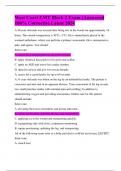Exam (elaborations)
West Coast EMT Block 2 Exam (Answered 100% Correctly) Latest 2024
- Course
- Institution
West Coast EMT Block 2 Exam (Answered 100% Correctly) Latest 2024 West Coast EMT Block 2 Exam (Answered 100% Correctly) Latest 2024 A 30-year-old male was rescued after being lost in the woods for approximately 18 hours. The outside temperature is 30°F (-1°C). He is immediately placed in th...
[Show more]



